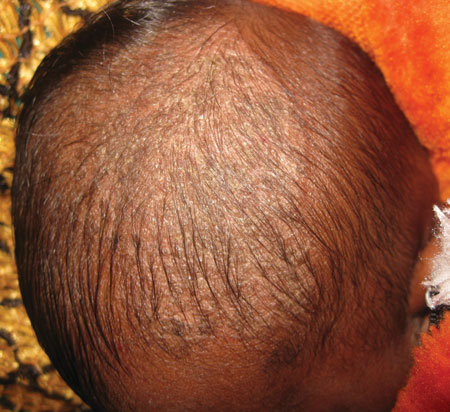A 3-month-old boy presented with a lesion
over the scalp for a week. Examination revealed a
well-defined patch with a greasy surface, and scaling on the
top of the lesion. It was surmounted by thick yellow-brown
crust (Fig. 1). Axillae, groins and other
areas of the body were free from any lesions; nails and
mucosae were normal. A diagnosis of cradle cap was made and
ketoconazole shampoo was prescribed.
 |
|
Fig. 1 Well-defined lesion
on scalp covered with crust.
|
Cradle cap is a type of seborrheic
dermatitis, exclusively affecting infants; more commonly
within first 6 weeks of life. It usually presents as
asymptomatic thick, crusty, yellow-brown patches. Fungal
infection (Malassezia furfur) and overactive
sebaceous glands are implicated in the pathogenesis. The
condition clears off as the baby grows older. Treatment
consists of removal of crusts with 3% salicylic acid; and
application of low-potency steroids and antifungal agents.
Clinical differentials include tinea capitis (easy
pluckability of hairs), atopic dermatitis (presence of
pityriasis alba, positive family history), impetigo (honey
colored crust), and psoriasis (scaly erythematous plaque
with involvement of other sites and nails).

